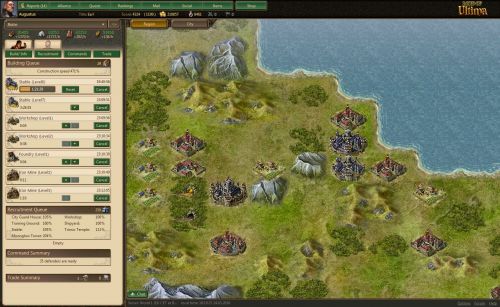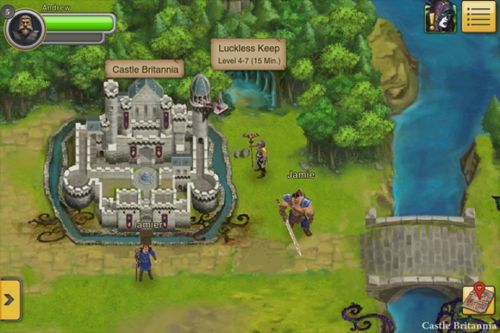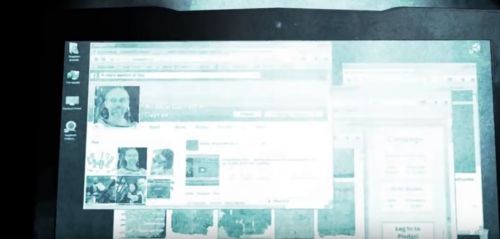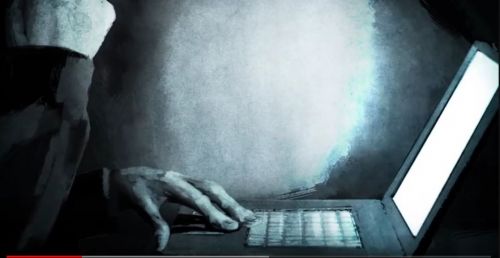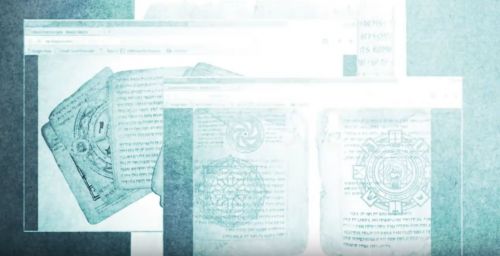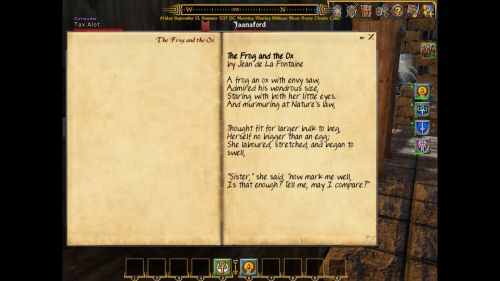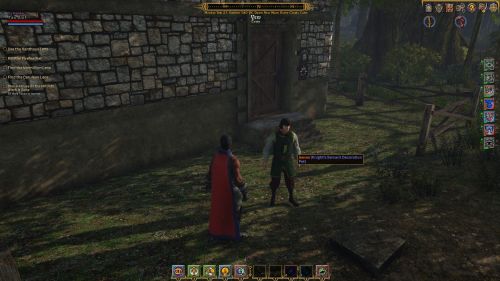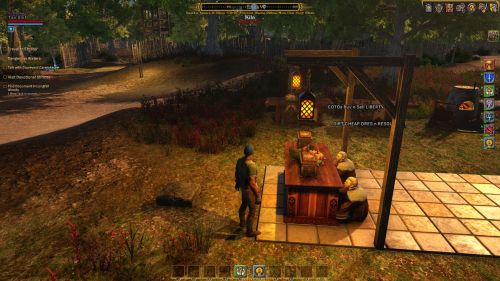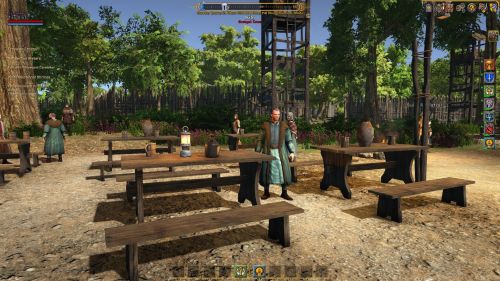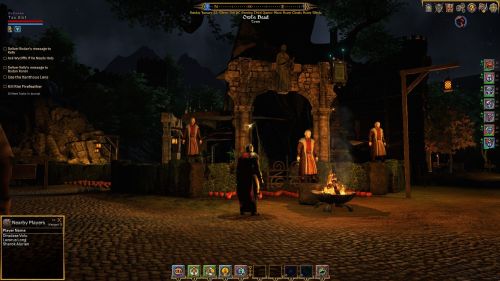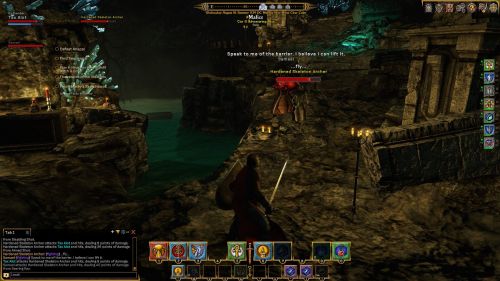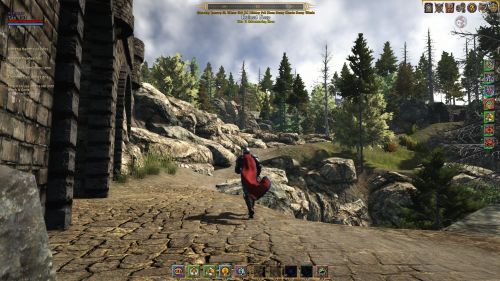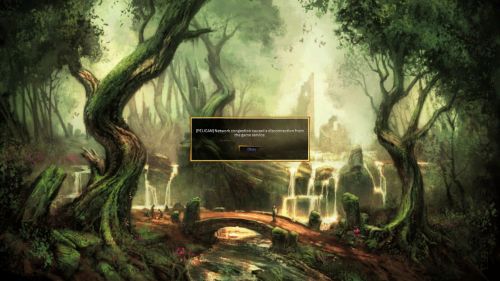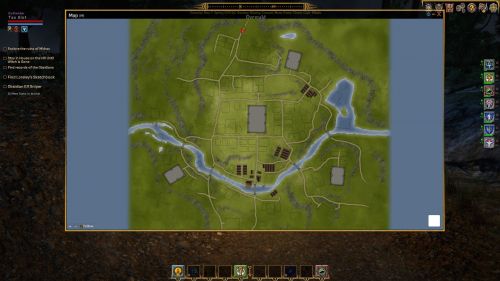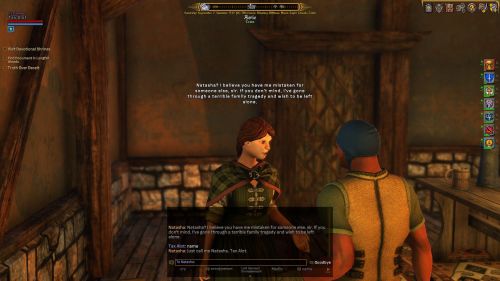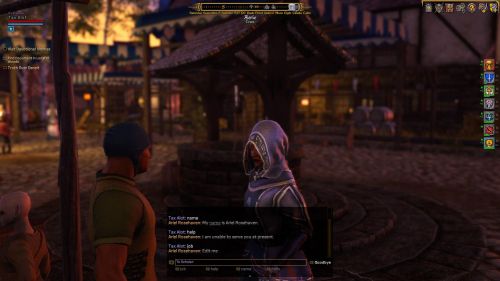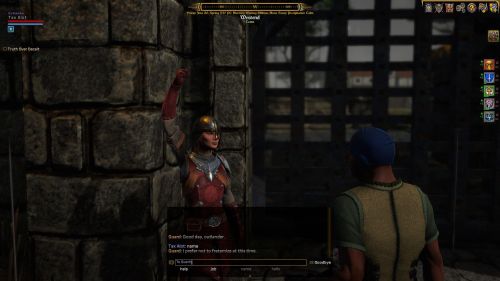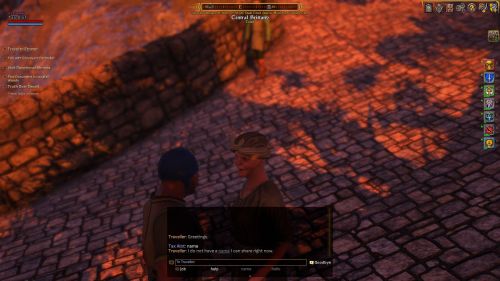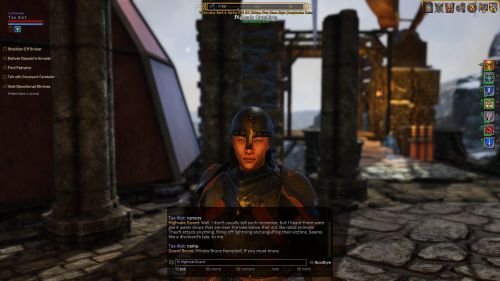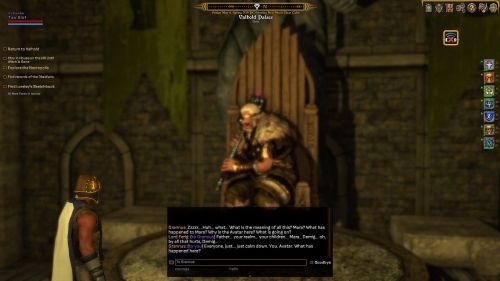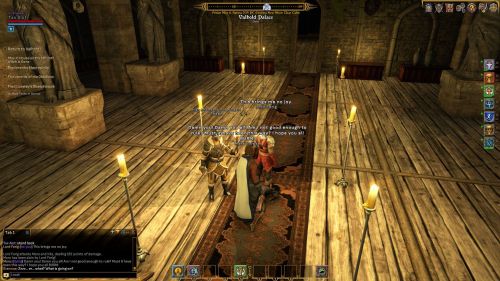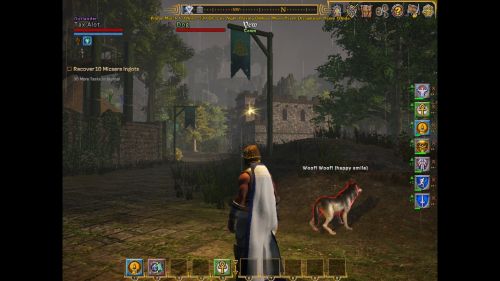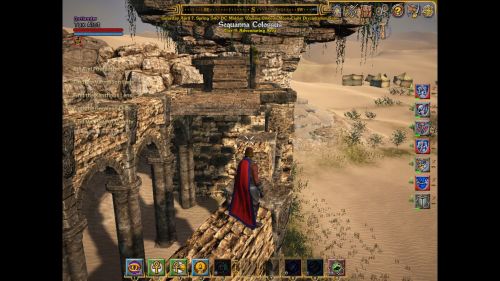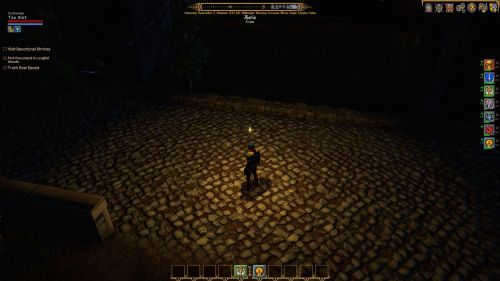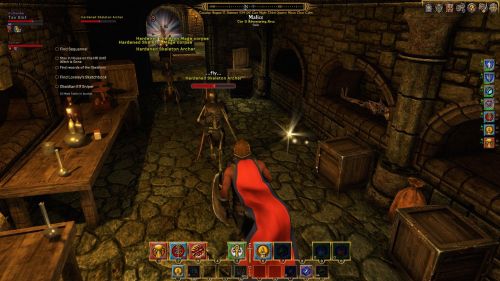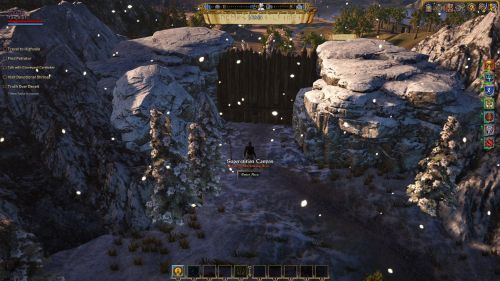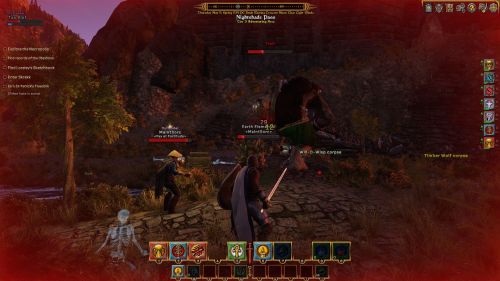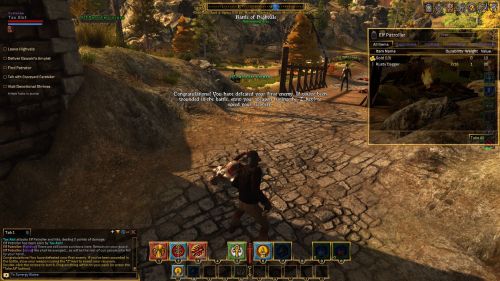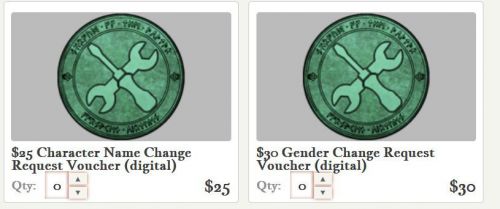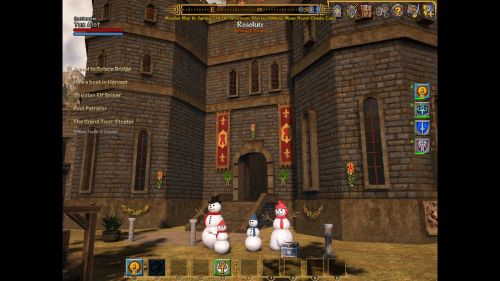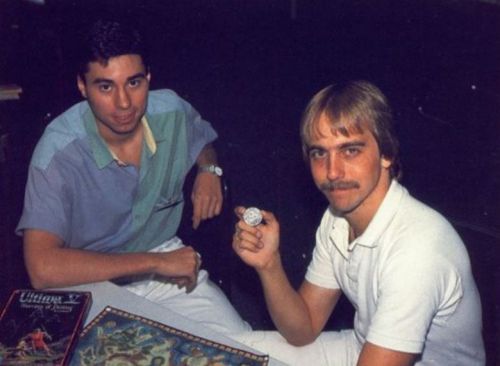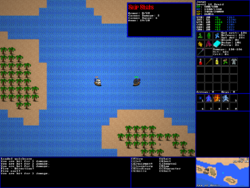RPG Codex Review: Shroud of the Avatar
RPG Codex Review: Shroud of the Avatar
Codex Review - posted by Infinitron on Fri 29 June 2018, 01:00:10
Tags: Portalarium; Shrouds of the Avatar: Forsaken Virtues[Review by taxalot]
Virtuous envy.
Shroud of the Avatar was, even before its official title was announced, even when it was just a thought communicated to the world as “The Ultimate RPG”, a very personal matter.
The Ultima community, for whom the game was supposedly intended first and foremost, had been through a lot since the release of Ultima IX. Mainly a whole lot of nothing, interrupted only by the prospects of an Ultima Online 2 (canceled), an Ultima X (also actually Ultima Online 2 (also cancelled)), a very loosely related browser game called “Lords of Ultima” (now dead), and finally “Ultima Forever: Quest for the Avatar”, a vague attempt at resurrecting the franchise as a free to play iOS game by Mythic Entertainment. Although it was mildly endorsed by Richard Garriott, Ultima Forever had nothing much in common with the Ultima series despite the similar game world and copious namedropping of the Eight Virtues and legacy Ultima characters which EA still owned the rights to. With Garriott having set sail to Zynga with his digital persona still in his pocket, the lazily named new queen of Britannia, Lady British, never saw the land she ruled ported to either Android or PC as promised, which was quite strange as I'd tested a functional PC client during beta before the mobile version was even announced.
Nothing much of value was lost when the Ultima Forever servers were unplugged, and so eyes turned back to His Majesty Lord Cantabrigian British, wide open to see if the man who had sought escapism in actual space could make his fans dream again with a new virtual fantasy world of the kind he and his team at Origin once knew how to create.
What had Garriott been up to, anyway?
I mean, besides the obvious.
The King had mostly kept out of the limelight since the disastrous Ultima IX. His attempt at creating another MMORPG, “Tabula Rasa”, had quickly turned awkward when it somehow underwent a genre shift from high fantasy to hot sci-fi action, pitting mankind (led by “General British”) against a race of insect-like aliens. This experiment did not end well, both for the game and for the parties involved.
The gruesome lawsuit that resulted earned Garriott enough cash to afford a few trips into space. But apparently not enough to fund an actual game, considering his subsequent adventure at Zynga where he made a wasthatevenagame called Ultimate Collector (‘the first social media game based on shopping and collecting').

The Ultimate Collector, Lord British's last project before SOTA, was a game about buying and collecting stuff. You can't make this up.
When that inevitably went offline, Garriott decided like so many others to turn to crowdfunding. With the Ultima community's support, he and his newly founded team at Portalarium would create a new adventure that was “totally not a sequel to the Ultima series” (it totally is) called Shroud of the Avatar.
Say what you want - the promise made to backers was interesting enough. A game that was both single player and MMORPG, offline and online, and would appeal equally to fans of both the classic Ultima series and of an Ultima Online that was now in dire need of an update. It was a unique enough pitch to get funded. But it probably wouldn't have gotten as far as it did if not for the the impressive cohesion of the Ultima Dragons, possibly the longest running video game fan club ever, their presence on the Internet predated by an earlier incarnation on the long defunct Prodigy network, somehow still around despite decades with no new Ultima games to talk about. The Dragons' fire burned hot for this game, and thus it successfully raised an initial “maybe a bit too reasonable” sum of $1,919,275, exceeding its $1,000,000 base funding goal.
But some wondered.
Was Richard Garriott still relevant? Did the man who had played such a dramatic role in the evolution of RPGs still have anything to say in a world of The Elder Scrolls, World of Warcraft and Witcher 3, games that now embodied the open-world gameplay, storytelling, and fully interactive worlds that Ultima was known for?
And how well could you possibly do single player in a game that was also an MMORPG? How would stories even work?
Over the course of the game's development, Kickstarter updates and pre-alpha builds would soon offer the beginnings of an answer.
It quickly became apparent that Portalarium's focus was not on creating a good story or a polished game.
The early builds that became available starting from the end of 2013 allowed you to walk around, and eventually to interact with other players, NPCs, engage in combat, craft, and so on. With almost every new month, a new build was released with new content and features. By the time of its official launch on March 27, 2018, Shroud of the Avatar had been playable for more than four years and Portalarium felt confident enough to take the game out of Steam Early Access.
Maybe they shouldn't have.
Through the Moon-Moon gate.
Shroud of the Avatar's introductory cutscene tries to appeal to the nostalgia of Ultima fans. Breaking the fourth wall, it shows you the player as a man (even if you planned to create a female character) who is apparently obsessed with Richard Garriott's Facebook page. The voice-over tells you that you are equally obsessed with ancient writings and tales of other worlds, disappeared civilizations and their forbidden knowledge.
But seriously, why? I know that it's important in an Ultima game to portray the Avatar not as a character but as the digital incarnation of the player, but I don't remember doing anything like this in Ultima. Also, if I actually did do this, then how much do I already know about SOTA's game world? About these lost civilizations that I supposedly read about on the “dark net”, as the voice-over explains? Because you know, that's exactly the kind of thing people do there, on the dark net. They install TOR and read about ancient magical civilizations. Then the drugs wear off.
Yes, I'm nitpicking.
But this is actually the first sign that something is wrong with the game's storytelling. Those signs will multiply and accumulate soon enough, and as a result, you will spend the majority of the game in a similar state of confusion.
The first decision you have to make in Shroud of the Avatar is whether to play in online or offline mode. While touted as a major selling point, the offline mode is just that - Shroud of the Avatar, but offline. You will not meet any other players obviously, and the player-owned town lots will also not be in your game. While I have not been able to check this out, apparently the game's storyline requires less grinding in solo mode, thanks to the NPC companions who can accompany you in this mode. It seems that Portalarium purposely designed the game to be more difficult in multiplayer, presumably because other players can help you there. Which is weird because many of the game's most difficult sequences are instanced, arbitrarily forbidding you from having a party with you.
And yes, as you've undoubtedly heard, SOTA has a real money marketplace. It's about much more than virtual house furniture, but you've probably guessed that too, right? More on that later.
The game's first zone is actually not New Britannia, but some kind of intermediary world. You'd call it “reverse purgatory” if you knew what was going to be on the other side. Greeted by a strange character named Arabella (who is actually, oh wow, Lord British's wife), you are led through a minor tutorial sequence that teaches you how to move around (WASD, thanks a lot for the help, Arabella), open doors (you click on them, thanks Arabella) before taking you to character creation, which is actually strangely decent as far as the appearance of your Avatar is concerned (let's just say that it is not TOO terrible for a game of its budget). You'll still look hideously plastic and expressionless of course, but you can be so in so many different ways that it's quite astounding that every other character in SOTA still manages to look just like his neighbor.
Indeed, the very moment you step through the portal after a pointless conversation with the Oracle, any doubts you might still have about the game's overall presentation will be confirmed. Shroud of the Avatar is a game that desperately wanted to have the scope and production qualities of an AAA title, but years of troubled development, the prioritization of multiplayer and monetization, and the need to maximize immediate profits while minimizing spending have instead produced a Frankenstein's monster of a game, both on the outside and on the inside. The first thing that comes to mind is the fable about the frog who wanted to be as big as an ox (and guess what, it's available everywhere in book format in all of New Britannia's libraries).
On the outside, the first thing a player is bound to notice is what's customarily called a “technical mess”. The game's framerate is abysmal, often dropping down to 20-30 FPS in city areas on my I7-4790k with Geforce 980 GTX, a machine that is no longer top of the line as I write this review, but is strong enough to get 60 FPS in games that look much better than Shroud of the Avatar. It becomes even more incomprehensible when you try to analyze what's killing the game's performance. In the busy scenes that trigger the slowdowns, I tried setting the graphics quality to low and there was absolutely no improvement. Meaning the bottleneck was my CPU, which is astonishing considering nothing much happens in the game physics-wise (might I even say nothing at all? I'm not even sure I even saw basic gravity effects), and in terms of AI the NPCs only need to do some pretty basic pathfinding (and that's only a very small number of them) and follow simple scripts (which is far from the Ultima VII-style living world that we were promised). I think it might have something to do with the scene being large, and the CPU needing to take care of objects that are extremely far away because of poor optimization?
Bah, who cares! The game is an unoptimized mess. And I'm not sure they'll ever be able to fix it, considering people were complaining about performance years before it launched. Portalarium are clearly aware of the problem - that they haven't addressed it says a lot about what you can expect from the game in the future. Release 54 supposedly featured numerous speed improvements, which I found completely unnoticeable. Even worse, it introduced a new bug that made the game ignore my resolution settings, resetting it to 1080p during map transitions. Thanks for that, Portalarium.
But is it pretty, at least?
Well…
No, it's not.
The Unity engine does a fair job rendering light effects, providing basic particles, reflections and bringing the game up to the standards of what is expected nowadays, but all of this is wasted by art direction that is often inconsistent with itself, or just too basic and underworked.
Each individual object in the game world doesn't necessarily look bad in and of itself, but taken as a whole, it's a valley that can't get uncannier. Between the art that is clearly ripped from the Unity Asset Store and dropped as is into the game (why are there paintings of Vasco de Gama in New Britannia? Why are there Greek & Roman statues everywhere?), the NPCs that are copy-pasted with so few models that you might literally see four or five copies of the same NPC mesh on screen at the same time, the absolutely incoherent mess that are the game's cities, where it's not rare to see snowmen, gothic torture devices, Tesla towers, and an outdoor market on the same screen (thank player housing, but not only that, as the Portalarium-designed areas are often just as chaotic), and dungeons environments that often have four textures at most (not to mention the super low poly count in these scenes)…
Well, you end up with a game that certainly has the potential to look pretty, but usually just makes you wonder why they didn't aim for a simpler goal. A simpler aesthetic with the camera set farther away from the character or even a 2D style would have kept oldschool Ultima fans, who had no expectation of state-of-the-art graphics, quite happy. Again, this is an issue that is unlikely to be fixed - because there are few complaints about it on the forums, because bad taste can only be addressed by adding new blood to the team and it's rather unlikely that Portalarium are going to be able to afford many new hires, but mostly because it doesn't seem to be the studio's main priority. As you spend more time in the game, two things will happen. You will become accustomed to the poor visuals as you lower your expectations, and yet the problem will only become more obvious as you visit the its many, many locations and see those same few assets copy-pasted all over the enormous game world.
And if that wasn't enough, there still some technical issues I haven't mentioned. In addition to the slowness, you'd better get used to redownloading the game. Shroud of the Avatar receives “monthly releases”, but said releases are sometimes patched. It's not uncommon to end up downloading ten gigabytes of patches a week, and this is a 7GB game. Load times are also very long, both when launching the game and during map transitions. And you'll be travelling between maps often in this game. Sometimes you'll walk 15 seconds on the world map and stumble into a random encounter that is way too high level for you. So you'll have to suffer through the loading screens for the world map, the random encounter map, and then the world map again, wasting 2-5 minutes of your life each time. This is something that will happen often, as if the load times for cities and just about everything else weren't bad enough already.
If you think that's not enough, get ready to be kicked repeatedly out of of the game because of “server congestion” (what?!), a concept my brain cannot wrap itself around considering how lonely it feels to play SOTA. Unless of course Portalarium's server code is as poorly optimized as their client code.
Sometimes it also kicks everyone out of the game because someone pressed the wrong button. Yes, that's something that actually happened.
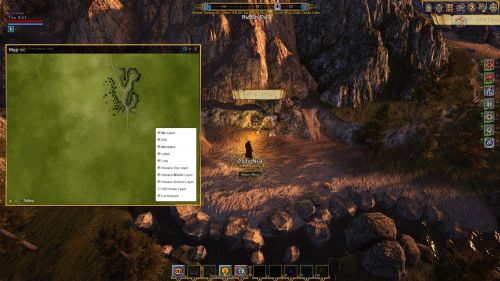
I should be seeing the world map here. This bug remains very frequent, and the only way to fix it is to log out and log back in.
And boy, do I hope you're not a Linux user. While the game officially supports the platform, they have not figured out how to make the minimap work on it, which makes the game almost unplayable in some cases considering how large some cities and zones are and how poorly signposted they are. The map, by the way, is just a webpage that's dynamically loaded and displayed in-game, which means two things - that it is also broken (several maps in the game do not correspond to the actual scene you are in!), and that yes, this online map does not work in the game's so-called offline mode.
You might have already come to the conclusion that Shroud of the Avatar is a bit unfinished, because it was released before QA and optimization were done. Well, just wait until I show you what content the game has to offer.
What's an Avatar?
I won't mince words. Portalarium absolutely failed to deliver the single player experience they promised to classic Ultima fans. But a good honest failure is one thing. It happens. It's sad when a developer fails to meet expectations or screws up, but it's nothing to be angry about. But the quest system, the storyline, and really just about every aspect of SOTA's content raise all sorts of questions. That thing you noticed about the visual assets repeating themselves, how it's a poor game trying to look rich, becomes much more problematic when you start trying to talk to people and do quests.
The first few areas are okay…ish. People will have things to say to you. The quests, while nothing phenomenal, make more effort than the typical quest in World of Warcraft while never actually reaching a quality that could be called “good”. For a game that was supposed to be about virtues and making choices, well, you'll usually never have any choices to make, and the ones you do make will never, ever, matter, other than a few optional lines of dialog from the Oracle that will make you wonder what the hell that thing is talking about and if it's about that stuff you did do, did not do, or did not do but the game thought you did because it was just another buggy day in New Britannia.
Move away from those initial zones and the ride really starts. The copy-pasted NPCs will start saying copy-pasted things. Prepare to discover enormous towns where NO ONE has a name, no one has a job (besides “generic item seller”), and of course, no one has a quest, something you have to talk to everyone to find out at first, but will quickly get used to when you find new towns and realize, oh, it's just another one of those.
And then the questions will start rising. Why? Why did Portalarium bother to make towns this big when they have nothing to offer in them? Britanny, the biggest town in New Britannia has NO NPC you can interact with other than a jester inspired by Noah “Spoony” Antwiler! What were they thinking? In recent updates, they've talked about filling that town with “backer NPCs”, but really, what is that going to achieve?
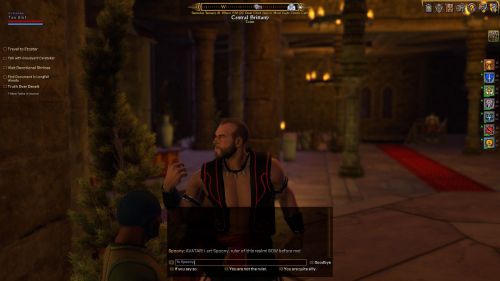
Spoony of “What's a paladin?” fame was the only NPC I was able to converse with in the town of Britanny, which has four entire maps.
As for the NPCs who are in the game, conversations with them are not very interesting. While Portalarium tried to emulate the friendly tone of the earlier Ultima games, you have to remember that these games were not only a product of their era, but were also set in much smaller universes where everyone could be a friend to everyone and the entire world felt like a global village. And that's when you can talk to the NPCs at all, because yes, some of them will tell you they'll be updated later or that they don't have a name ‘right now'.
The keyword system that was supposed to be a throwback to the classic Ultima games doesn't work. Some keywords are missing, others don't register when clicked. There are characters who refuse to acknowledge that you completed their quests, and worse, characters who thank you for completing a quest that you haven't even gotten. The conversations themselves tend to be lengthy and are usually absolutely uninteresting, trying way too hard to recreate that oldschool Ultima feeling.
But in Shroud of the Avatar, what characters don't say is just as much of an issue. Which brings me to my next topic, which is why this game's story doesn't work.
“Forsaken Virtues” is actually meant to be the first chapter in a series of five games using the Shroud of the Avatar engine. As such, it's supposed to introduce the player to the game world and its current situation, while hinting at a larger story.
As I said earlier, you're dragged to New Britannia after reading whoknowswhat about runes and ancient civilizations, at which point you meet two characters. There's Arabella, who you'll run into in various places throughout the game to remind you what you're supposed to do in the main quest with both cryptic clues and obvious instructions (because “mysticism” and “Lord British's wife”), and the Oracle, who will give you the classic Ultima virtue questionnaire (the questions are mostly the same as in the old games) before setting you on one of three paths - Love, Truth, or Courage. A solemn process made absolutely pointless when the Oracle tells you at the end that if you want to, you can just switch to whatever path you want. You will quickly realize that this choice merely determines your starting location and has no meaningful consequences.
The Oracle and Arabella will tell you that you must complete the paths of Truth, Love and Courage to “fulfill that destiny” and all that jazz you've probably heard a million times before. What is your destiny? To fulfill the “Dirae prophecy”. What is the Dirae prophecy? You will have no idea. What is a “path of Truth”, “path of Love”, and “path of Courage?”. You will never know this. In practice, they're big quests that feel disconnected from the prophecy and are barely associated with their respective virtues.
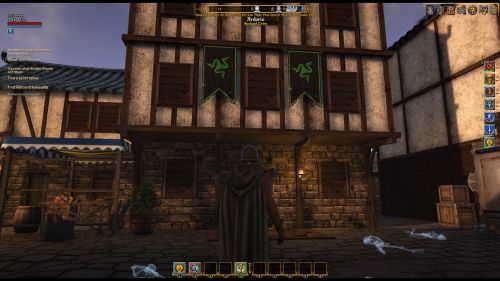
It's difficult to associate the main quest with its related virtues, but it's much, much easier to associate it with Razer, Mouse and Keyboard for the exigent gamer. Please don't forget to buy your Razer accessories at your nearest retailer.
The connection between the paths and their associated quests will remain unclear at best until you reach the end of each quest and meet its Titan.
The Titans are… beings? Until you get to meet one of them, the Titan Grannus, their nature will be vague. Are they worshiped as gods? Are they embodiments of the virtues? Are they the rulers of the world? And if not, who does rule this world, it has to be Lord British, right? But he's “not here at the moment” and absolutely no one mentions him or refers to him as a ruler, even though he has the biggest castle in the biggest town. Where is he? Is he missing? Has he disappeared? Why aren't people talking about the zombie invasion that is happening in another part of the land? If the Titans are so important despite not having been seen for ages, to the point where people talk about them as if they're mythical, why hasn't anyone tried to check up on them? How are they considered mythical when they have their own castles? Why am I obeying the Oracle when it's obvious from the beginning that there's something fishy about it? Why does nobody care that the world seems to be at war with a group called “The Ebon Cult” who are attacking and laying siege to cities? Why are they laying siege to cities? Why won't anybody tell me why they seem to hate the virtues? Why does no one care about this war? Do they hate the Oracle too? I'm being told about an ancient evil group called “The Obsidians” who were pretty mean to the entire world. Why? Doesn't anybody know?
What the hell is going in this game?
As you go through the story, some of these questions will eventually find answers. But it happens far too late in the game to be considered decent or even acceptable storytelling. Withholding basic knowledge from the player only to reveal it randomly during some quest is pretty terrible writing. Where was Tracy Hickman?
Speaking of which, some of these oversights are resolved with incredibly long loredumps that seem to refer to the Sword of Midras novel written by Hickman that you probably haven't read and probably don't intend to. This makes entire chunks of dialogue incredibly confusing. Awkwardness abounds every time the game tries to do something big with its story, to be honest. A climactic scene where elves are destroying a city turns strange when the game decides I'm in a tutorial, congratulating me for killing my first enemy when I've been playing for over 30 hours and merely happened to stumble into the “starting zone” of one of the other paths.
At one point I had to meet with a kobold king in an underground city, which saw me walking through this huge area filled with dozens of NPCs I couldn't interact with for what seemed like 5 to 10 minutes, only to eventually meet some kind of steward who asked me to follow him across the castle at a pace so slow it had to be seen to be believed.
In another instance, some kids had just died in a dungeon, an old Ultima tradition. I was then accused of killing those kids, which I had not. It was some kind of trap that just sprang on its own. This didn't stop other NPCs from trying to try to guilt me for having killed them.
A meeting with one of the Titans turned more otherworldy than intended, taking place as it did in his enormous castle, a major center of politics and power in that region of the world, populated by a grand total of two NPCs.
One of the game's three paths leads you from one NPC to another for hours on end, before finally sending you into a dungeon with no combat whatsoever.
There are sidequests where an NPC asks you to meet in a town on the other side of the world, and then it's not actually clear if the town map is broken or if he just isn't there. Incidentally, that's something that some NPCs in this game do. They're in several towns at the same time, because… reasons? In at least one instance I saw an NPC in a town, then in another town, then dead on the ground in a wilderness zone, and then in some town again. I had no idea why the guy was traveling around so much.
All in all, the storytelling and quests, both sidequests and the main quest, appear to be a complete afterthought. The overall impression is that of something that is more pre-alpha than release, with NPCs placed in placeholder zones with placeholder text so that they can switch the game flags that allow the story to progress. While the main quest isn't quite as buggy and uncompletable as it might appear to be, progressing it always feels like a miracle. A miracle that hasn't been proofread or given too much thought. And yes, to reiterate, moral dilemmas, choices and consequences are all totally absent.
This might be viewed as a limitation of the engine and of the multiplayer format, except that MMOs these days have figured out how to do decent storytelling. You can be sure that nothing of great importance will ever happen in Shroud of the Avatar. After all, all the players have to inhabit the same consistent world.
It is not much of a spoiler to say that after completing the three paths, the game continues on for a fair bit of time. For quite an unnecessary length of time, in fact. You are asked to travel around the world through high level zones to retrieve a series of eleven items that have been scattered in some very dangerous places. This is a pain. This is bad design. Common sense dictates that you just run for the desired item and then run back out of the map when enemies start getting too strong for you. Common sense should also have dictated that the designers avoid creating platforming segments where enemies attack you from a distance, especially considering the troubled history the Ultima series has had with that sort of gameplay.
These scenarios are incredibly tedious and do nothing but artificially lengthen the game.
Gameplay is an overrated idea.
Even though gameplay is not where Shroud of the Avatar fares the worst, even though the game somehow manages to stumble randomly into the “entertaining” zone once every couple of hours, your mileage on that front may vary considerably depending on a number of factors. Have you played many MMOs? Are you looking for deep, involved combat mechanics? Do you want challenging PvP and interesting PvE events? If you replied “yes” to any of these, you're going to be disappointed.
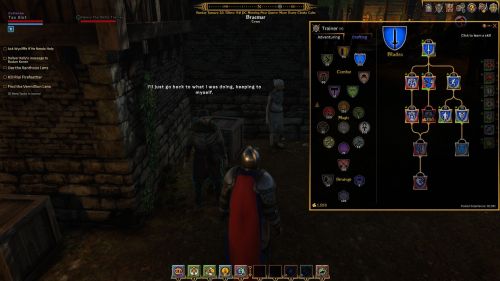
The skill tree IS interesting. But because of how large the window is, it's almost impossible to drag anything in it to the action bar if you're not playing the game in high resolution.
You'll be disappointed because while SOTA retains the gameplay mechanics of many of its contemporary MMOs, it never outdoes them and at best attains what could be called “average”. Combat is based on the usual “build several decks of abilities in the hotbar, grow skills, use them and wait for the cooldown” paradigm. Weapons have different effects - some are able to hit multiple enemies surrounding you, some aren't impacted by shields, and so on. Some enemies are more vulnerable to certain types of magic and less vulnerable to others. In short, all of the usual MMORPG tropes are in there, with a depth that seems like it should be sufficient, which is surprising considering how shallow the rest of the game feels. But I still couldn't tell you why you should play this game over a million others that offer pretty much the same thing. SOTA is a game that was supposed to be a throwback to the classics, fighting on an MMO landscape dominated by World of Warcraft, but I found its gameplay to be more or less a bad WoW clone.
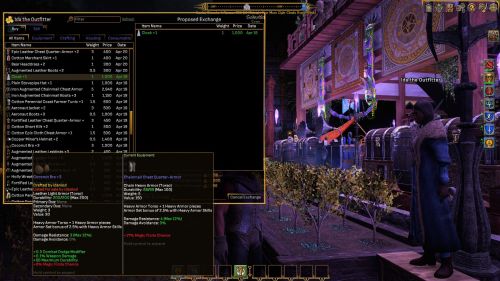
None of these items interest me. I haven't been interested in anything a store has had for sale since I found the music sheet for Right Said Fred - I'm Too Sexy.
However, if you want one example of something that SOTA does differently from every other MMO besides UO, and actually does a great job at, then it has to be the skill system and character progression. Yes, this is the paragraph where I'm going to say some nice things about Shroud of the Avatar. And I mean them sincerely, though moderately.
Being a throwback to the Ultima Online of yore, Shroud of the Avatar tries to do away with the classic leveling system that you tend to see in just about every MMORPG. While the game retains something called an “Adventurer Level” and a “Producer (crafting) level”, it is quite unclear what these do. Heck, I'm not even sure what experience points in this game are for. The UI says they're for learning skills but I never saw the connection. Learning a skill seem to depend only on money and the current value of said skill. Portalarium also mention “XP for killing monsters” but I only seem to get notified for XP when I complete a quest and not when I kill a monster.
Yes. Hello Portalarium, is it normal that after 100 hours of game time I'm still not sure what experience points are for? What adventurer level is for? I checked a wiki, but it's outdated and refers to systems that were present in 2014 but were replaced long ago. Here's the thing - I'm pretty sure that some people know how it works, mainly people who have been playing since the earliest releases. But all I've seen are videos on YouTube by people with “theories” and forum posts trying to guess what exactly it does. I'm pretty sure you get XP by completing quests. I'm also pretty sure it raises your adventurer level which raises your HP and MP maximums. I read somewhere that XP points go into a pool that is consumed when you raise your skills. Some people say that said pool should be managed but once again, after 100 hours of playing, I've yet to find the point of that. It's never really explained in the game. Just look it up online, will you?
Anyway, I was supposed to say some nice things here, so let's get to it. The main method of progression is not XP nor levels. Combat and crafting skills level up individually the more you use them (yes, it's similar to Daggerfall). At first new skills are nerfed pretty badly, but after using them enough, you gain access to their full effectiveness and even get some bonuses. Skills range from magic to mundane melee. There's your different schools of magic (air, fire, moon, light, sun…) and your different weapon skills that all seem pretty standard (though seeing them level up as you train is not only addictive, but fairly rewarding compared to the usual system where your skills become more powerful when you gain a new level for no reason at all). Improving your skills eventually allows you to unlock further skills down the tree after a visit to a local trainer. There are a wide variety of skills, allowing for more than a fair share of gameplay styles. It's also possible to “multi-class” (in a manner of speaking, as the game is classless). This is actually the recommended way to play if you want to play the game solo like I did, considering how many hurdles you have to jump through.
I wish I could say the skill system alone makes the game enjoyable, but it really doesn't, because SOTA has some balance issues. Actually, a more accurate statement would be that it makes no attempt at balancing whatsoever.
While the game takes it easy at the beginning, starting out in zones where you can handle pretty much everything that is thrown at you, things will change rapidly once you leave the early areas. The game is divided into town zones and adventuring zones. Town zones are safe havens where pretty much nothing can happen to you. Adventuring zones might have a few settlements and NPCs, but you're going there mostly to battle, grind, and quest. They're ranked “Tier 1” to “Tier 5”, a system that sounds nice on paper considering the game is pretty much levelless but which quickly proves to be completely broken for multiple reasons.
First, the difficulty curve in this game is incoherent. The main quest doesn't hesitate to take you from Tier 1 zones straight to Tier 4 zones. Some Tier 4 zones are actually easier than Tier 2 zones because defeating one tough enemy is easier than defeating ten weak skeletons who jump you simultaneously. Other times, the system simply lies and places incredibly tough enemies in tiers that should be accessible to you.

Contrary to appearances, I did not die of boredom here. But I might by the time I find a resurrecting glowing ankh.
When you're stuck, you might decide to go do some sidequests instead. But these are so rare, so broken, and their rewards so random that it's hardly a solution, leaving you to wander the world, switching from one path of virtue to the other, looking for stuff that your character can actually do before you inevitably get stuck again. Soon you will realize that avoiding combat and running around like an idiot to get to the item/NPC/area you're looking for is a much more viable strategy than actually fighting your opponents. In some cases though you will actually have to defeat a couple of bosses, and this is where the game can become a real pain and turn into a grindfest. As I said, apparently less grinding is required in the game's offline mode where you have access to companions, which means that Portalarium know that this is an issue for solo players, but could care less. Are they trying to get you to buy equipment in the real money marketplace? Not really, as it's fairly easy to get the equipment you need early on. There's not a lot of variety in terms of items - armor comes in leather, chain, plate and that's it. Items that are “special”, rare, or enhanced are incredibly rare, expensive and give you bonuses so limited that they're not worth buying. Said items are often sold by other players in their custom shops at prices that redefine the word “ridiculous”, so it's great that you don't actually need them. But still, you're stuck. And the only way out is by grinding your skills. Luckily for you, death penalties are almost nonexistent - the usual “go to a resurrection point or wait and suffer some debuffs” routine.
And indeed, Portalarium, how do you balance a game that had its last character wipe two years before it was actually released?
The answer is that you don't. Old players who like the game will have strong characters and won't notice the difficulty issues, while new players will just leave the game en masse, as they're currently doing at the time of writing this review.
And it's not like visiting adventuring zones is much of a reward in and of itself. You'll get to fight bandits with green hoods, skeletons, slimes, wolves, bears, and… that's it. No really, that's really it. I've just given you a list of 95% of the enemies you will ever fight in this game. There are a couple of special ones, like giant trolls, at least one phoenix, a dragon, liches, etc, but they're rare high level content. You'll mostly be fighting the same enemies over and over again. Sometimes a skeleton becomes a “hardened skeleton” or an “Ebon Cultist” becomes a “Thug”. There's your variety.
One might think that Portalarium mean to address this issue, but since I started playing all they've done is announce a new type of skeleton (now with pirate hats!) and a new type of zombie (now they're children!). I guess they haven't found any new Unity assets they like yet.
The adventuring zones are incredibly tiny compared to towns and are variations on common MMORPG tropes. Desert zone. Ice mountain zone. Forest zone. Swamp zone. Dungeon zone. Maps are usually different going from one zone to another, but that's not always the case. Many of the adventuring zones are clones of each other and are now gradually being “un-cloned”, more proof that the game wasn't ready for release.
Shroud of the Avatar wants to be huge, and that was Portalarium's deadly mistake. The biggest hope and the biggest lie they sold to their backers was the game's scope, which is also its biggest issue. It was far too big for them to ever finish properly.
So, combat is repetitive and not too great, and questing is broken. But a major part of the appeal of Ultima Online was its “out of combat” gameplay experience. It featured an ambitious, diverse economy in which being a fisherman, woodcutter, tailor or blacksmith was a viable playstyle if that was your thing. How does SOTA fare in that regard?
The answer is… not too bad, I guess? But not especially great either. I will admit that I only care only about these sorts of mechanics insofar as they can provide a source of income to allow me to further my questing objectives, but I did try to look into it. And I have played other MMOs besides SOTA. So let's just say that I'm not exactly impressed. SOTA does a decent job of allowing you to create weapons, clothes, or even furniture for your house. If you really love that sort of thing, it's all there. But again, if you compare it to other games like World of Warcraft, does it really offer that much more? I guess there's furniture arrangement. I guess there's book writing. I guess there are music sheets. Yes, SOTA allows you to play individual musical instruments, manually or automatically using sheets. Be ready to hear classic Ultima themes in taverns, and to see people dancing to anime opening themes being played on pianos. And if that's not immersion breaking enough for you, you can also attend the Darkstarr dance parties or turn on a radio in the game's various taverns. Tune in to “Avatar Radio” or “Radio Free Britannia” and listen to Cyndi Lauper's “Girls Just Want To Have Fun” while you try to talk to some NPC into accompanying you into an undead-overrun city.
But I digress. As I mentioned, Shroud of the Avatar allows you to buy houses and towns. However, unless you're absolutely super passionate about the game and spend a lot of time farming, you'll never earn enough money to do it. Just look at those prices on the Portalarium store.
Ready to cash in? Keep in mind that housing lots are also subject to taxes. Be late on your payment and you can say goodbye to the landlord life. The latest Portalarium community livestream made a point of emphasizing how they're now able to send reminder emails to players who haven't paid on time. They seemed elated about it, though I'm not sure about their idea of a “reasonable amount of time” to pay up.
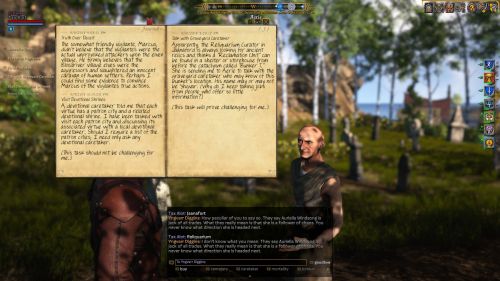
This quest doesn't work. The caretaker doesn't respond to anything I've been told to say to him. By this point in the game, you'll be used to this.
One way to earn money is to acquire your own shop. But when you look at the prices of items in this game, you'll wonder who would possibly buy anything in one. The best weapons, which appear to be only marginally better than the basic ones, are sold at prices that are just insane.
I think I've said all there is to say about Shroud of the Avatar's gameplay mechanics. I didn't mention PvP because it is the very definition of basic - you flip a switch and now players can attack you in towns. Some zones (temple ruins) are PvP by default because reasons. And there are dungeons which you can raid with other people. That's it, really. By the way, even if you're not into multiplayer adventuring, be prepared to have a lot of buddies, because the most effective form of travel is to just friend request everyone you meet and use “Teleport To” scrolls. Really well thought out design.
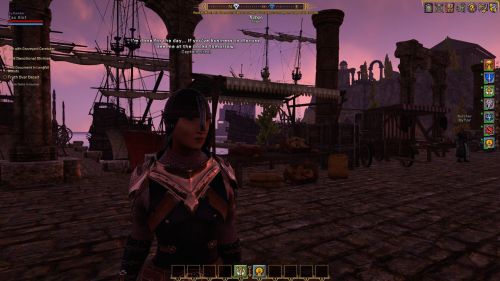
Stuck on an island. Obviously, nothing happens if you talk to this NPC “tomorrow”. I had to teleport myself out of this zone to a “friendly” player.
Shroud of the Avatar is not some little game. It's not just a couple of tiny towns, with a dozen dungeon levels and a main quest that you can complete in 15 hours that you might expect from a small indie team. No, Portalarium made a huge game and filled it with nothing. The game quite possibly has hundreds of towns if you include player-owned ones, but only five or so contain anything of interest. There is absolutely NO POINT to the player-owned towns if you're not into housing or crafting. Seriously, don't go into them, it's a waste of time. You will get lost. You will meet no interesting NPCs. You will find no incredible deals, because everyone is trying to sell their stuff for ludicrous prices. Meanwhile, sidequests are either uninteresting, broken or just not there, with an incredible number that refuse to flag as “completed”, which means they remain in your quest log until the end of time. And if you were hoping to find new and rare items in this game, prepare to be disappointed. They don't exist. Unless you're willing to engage in crafting (with custom design, which I admit is a nice touch) or buy them for ridiculous prices, you will never own any special equipment.
Had Portalarium gone for a smaller scope with the same budget and even the same technology, they might have been able to deliver a finished product. A competent RPG that probably wouldn't have made any Game of the Year lists, but would have been enough to satisfy Ultima fans.
But here's the thing. Portalarium's intention from the very beginning of the project was to emulate the living, breathing world of Ultima Online in its early days. The classic Ultima series was known for its focus on immersion. For some reason, their marketing department decided that the best way to immerse Ultima fans was to sell them houses.
And sold they did. The first consequence of this was that if you backed the game for the single player experience… well, you probably gave up hope the moment your bank account was debited. To someone who was looking for a great single player adventure, the monthly emails focused solely on player housing were utterly depressing, an obvious sign that Portalarium had taken your money and were doing whatever the hell they wanted with it. Month after month, the studio unveiled new kinds of houses that you could buy with real money. But why stop at a house? Why not buy a castle? Or a whole town? You could do that too, as a solo player or as a guild to have your own place to regroup. The emphasis on this aspect of the game was truly puzzling. Between that and the monthly dance parties thrown by “DJ Darkstarr” (executive producer Starr Long's alter ego), one might wonder whether the point was to have exciting adventures or just to create some sort of virtual renaissance fair for everyone to LARP in. In many ways, it felt like Portalarium were increasingly less interested in selling a game than a medieval Second Life service.
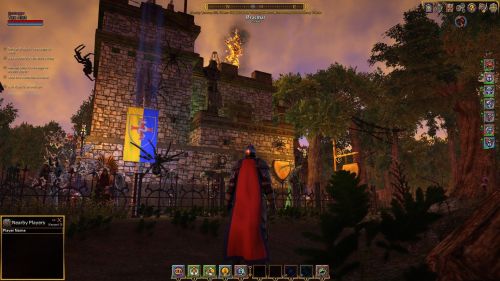
The Portalarium banner. Giant fake spiders. Laser beams. Flaming statues. Scarecrows. Ankhs. Yes, this is player housing.
To give people their houses Portalarium had to offer land, which explains why town maps in SOTA are so huge. Typically about three quarters of each town is occupied by player-owned buildings and empty lots. I would also estimate that around 80% of the towns in the game are either player-owned towns or towns that exist solely in order to sell more land. It makes exploring the world a completely excruciating experience, because of the unnecessary loading, because of the difficulty navigating this anarchic urban development, and because these towns are phantom zones.
No one ever visits other players' houses.
The player-owned towns are always, always empty.
The player-owned shops sell items that are either ridiculously priced, useless, or most often both.
Ultima was a mistake.
It's nothing but trash.
Portalarium has allowed its player base to fill 80% of their game world with useless junk. It was a matter of survival for them. Fans have started analyzing their SEC filings and have concluded that their financials might be… not so good. And there are plenty of smoking guns elsewhere. Steam player counts are low and disappointing (although to be fair the game can be run from a separate launcher that bypasses Steam). The release was clearly rushed, considering how broken the game remains at this point. Its storyline barely exists and feels like a last minute addition to fulfill contractual obligations. SOTA has the basic structure of a game but lacks everything else.
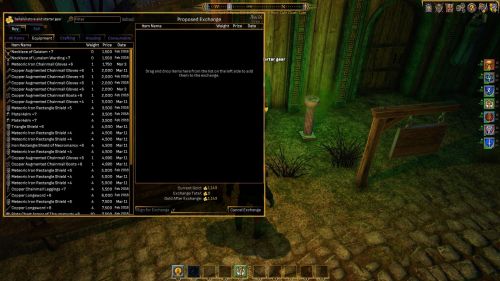
These special items have stats that are the same as or only marginally better than the standard varieties, while costing five to ten times as much. It would take hours of farming just to buy a single item from this store.
Hence the ever-increasing emphasis on housing to bring in immediate revenue. And you know, selling people houses that don't exist and barely work is one thing. Selling them “horse statues” that are free on the Unity Asset Store is a whole other level. Not to mention selling the ability to build SOTA's dungeons. That's right, there are people who are paying for the privilege to be allowed to work on this game, which is shocking in and of itself. Seeing stunts like this being defended on the official forums is mind-boggling.

This post was a reaction to a player's complaint that after three years, he hadn't yet received the town he paid for with hard cash.
Start digging and you'll find that the rabbit-hole goes deeper. Portalarium have to do monthly beg-a-thons to pay the team's salary. Reading their forums is an otherworldly experience. People who politely complain that their promised town (that they bought with actual money) hasn't been delivered are accused of “publicly shaming” the “hard working people of Portalarium”. The “reviews are not so good” thread is, at the time of this writing, focused on dance parties and how they could be better. There's a post by Starr Long saying that the reason combat feels lackluster is because it doesn't have the right sound effects and that the team is working hard to improve that. Dig even deeper and you'll find posts defending the in-game Razer advertisements and the aforementioned horse statues.

The official website. If you backed the game at the $400 tier, you can work for Portalarium for free. Happy?
You'll see posters explain at length that what they really want from the game is a bigger focus on fishing. Someone else asks if the game could be ported to the Raspberry Pi and people actually discuss it seriously rather than express immediate disbelief. Even if you go outside the official community and talk to the general Ultima Dragon fanbase, you'll find that while many of them are dismissive of the game, a fair number appear to defend it in ways that would seem unimaginable when you consider that their main bone of contention during Ultima IX's development was that it wasn't hardcore enough. Listen to the Ultima Codex podcast and despair as discussion revolves around how the game could be improved by “enlarging the text window”, “improving performance” and “rebalancing some areas”. In private conversations, some rejoice that they can finally buy their way out of a game's difficult moments instead of having to “pass exams” all the time.
What the hell?
SOTA feeds on blind loyalty. It thrives on the fortunes of people who are too easily parted with their money, question too little, and seem ready to accept anything as long as it's a pretext to meet each other again with an endorsement from Richard Garriott and an Ultima reference namedropped here and there.
Raking in easy money by selling virtual properties to people who who will defend anything you do no matter what due to nostalgic loyalty. Even if you haven't followed SOTA's development, that might sound familiar to you.
It's a marketing scheme that's oddly similar to Star Citizen's.
Why, it's almost as if Chris Roberts and Richard Garriott know each other.
I take no pleasure in disparaging the Ultima community in this way. This is after all merely a game. However crappy and unfinished it is, people have a right to enjoy it however they want. If they don't, well, that's always been part of the risk of buying a game. We've all been there.
You might reply by telling me that the community isn't part of the game. That it can be ignored.
But no, not this time. It shouldn't be. As I wrote at the beginning of this review, SOTA is a deeply personal affair between a studio and its fanbase. This is a review of a game that is still in development, that is still being worked on month after month. As such, it's the community that determines SOTA's direction. Tolerating the intolerable is what made SOTA the mess it is right now, a mess that it'll probably never recover from because you can't really work to fix its issues with the kind of feedback that spawned them in the first place. SOTA doesn't have a fishing problem. It doesn't have a UI problem. It has a completion problem. It has a direction problem.
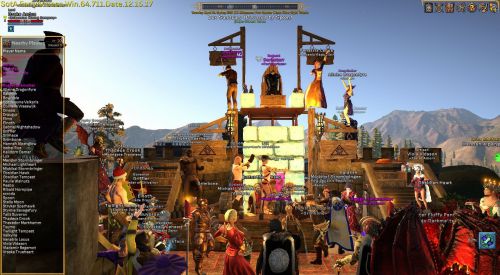
This image taken from the official forums shows a typical SOTA dance party. Second Life has met its match.
All that's left to do after you've bought SOTA and played it a bit is to try and guess at a very uncertain future. Releasing the game in such a state is not a good sign. Adding pirate hats to skeletons as a last resort to increase enemy variety seems more than a bit problematic. The monthly livestreams where the developers beg for money should be setting off all kinds of alarm bells. Selling virtual items they got off the Unity Asset Store or asking that players pay for the right to work for them is either shamelessly cynical profiteering, or the sign of a studio that's grasping for any idea that might allow it to survive for one more quarter before its inevitable bankruptcy.
Clearly, there are a fair number of fans out there who are still positive about Shroud of the Avatar. They will allow the game to survive. It'll get its five episodes (which means five time the land mass, five times the quests to debug, oh good lord…)
To these optimists I can only say, I hope you're right.
Somewhere within SOTA there is a seed of something that could be called a decent homage to Ultima. Give it a couple more years of bugfixing, rewriting and polishing, and a more down-to-earth community, call the result the “actual, real, release” and you might end up with a game's that tolerable to random bystanders and superbly nostalgic for Ultima fans.
But if you're wrong? In that case, you just spent a whole lot of real money on a game whose servers might be shutting down pretty soon.
Virtuous envy.
Shroud of the Avatar was, even before its official title was announced, even when it was just a thought communicated to the world as “The Ultimate RPG”, a very personal matter.
The Ultima community, for whom the game was supposedly intended first and foremost, had been through a lot since the release of Ultima IX. Mainly a whole lot of nothing, interrupted only by the prospects of an Ultima Online 2 (canceled), an Ultima X (also actually Ultima Online 2 (also cancelled)), a very loosely related browser game called “Lords of Ultima” (now dead), and finally “Ultima Forever: Quest for the Avatar”, a vague attempt at resurrecting the franchise as a free to play iOS game by Mythic Entertainment. Although it was mildly endorsed by Richard Garriott, Ultima Forever had nothing much in common with the Ultima series despite the similar game world and copious namedropping of the Eight Virtues and legacy Ultima characters which EA still owned the rights to. With Garriott having set sail to Zynga with his digital persona still in his pocket, the lazily named new queen of Britannia, Lady British, never saw the land she ruled ported to either Android or PC as promised, which was quite strange as I'd tested a functional PC client during beta before the mobile version was even announced.
Nothing much of value was lost when the Ultima Forever servers were unplugged, and so eyes turned back to His Majesty Lord Cantabrigian British, wide open to see if the man who had sought escapism in actual space could make his fans dream again with a new virtual fantasy world of the kind he and his team at Origin once knew how to create.
What had Garriott been up to, anyway?
I mean, besides the obvious.
The King had mostly kept out of the limelight since the disastrous Ultima IX. His attempt at creating another MMORPG, “Tabula Rasa”, had quickly turned awkward when it somehow underwent a genre shift from high fantasy to hot sci-fi action, pitting mankind (led by “General British”) against a race of insect-like aliens. This experiment did not end well, both for the game and for the parties involved.
The gruesome lawsuit that resulted earned Garriott enough cash to afford a few trips into space. But apparently not enough to fund an actual game, considering his subsequent adventure at Zynga where he made a wasthatevenagame called Ultimate Collector (‘the first social media game based on shopping and collecting').

The Ultimate Collector, Lord British's last project before SOTA, was a game about buying and collecting stuff. You can't make this up.
When that inevitably went offline, Garriott decided like so many others to turn to crowdfunding. With the Ultima community's support, he and his newly founded team at Portalarium would create a new adventure that was “totally not a sequel to the Ultima series” (it totally is) called Shroud of the Avatar.
Say what you want - the promise made to backers was interesting enough. A game that was both single player and MMORPG, offline and online, and would appeal equally to fans of both the classic Ultima series and of an Ultima Online that was now in dire need of an update. It was a unique enough pitch to get funded. But it probably wouldn't have gotten as far as it did if not for the the impressive cohesion of the Ultima Dragons, possibly the longest running video game fan club ever, their presence on the Internet predated by an earlier incarnation on the long defunct Prodigy network, somehow still around despite decades with no new Ultima games to talk about. The Dragons' fire burned hot for this game, and thus it successfully raised an initial “maybe a bit too reasonable” sum of $1,919,275, exceeding its $1,000,000 base funding goal.
But some wondered.
Was Richard Garriott still relevant? Did the man who had played such a dramatic role in the evolution of RPGs still have anything to say in a world of The Elder Scrolls, World of Warcraft and Witcher 3, games that now embodied the open-world gameplay, storytelling, and fully interactive worlds that Ultima was known for?
And how well could you possibly do single player in a game that was also an MMORPG? How would stories even work?
Over the course of the game's development, Kickstarter updates and pre-alpha builds would soon offer the beginnings of an answer.
It quickly became apparent that Portalarium's focus was not on creating a good story or a polished game.
The early builds that became available starting from the end of 2013 allowed you to walk around, and eventually to interact with other players, NPCs, engage in combat, craft, and so on. With almost every new month, a new build was released with new content and features. By the time of its official launch on March 27, 2018, Shroud of the Avatar had been playable for more than four years and Portalarium felt confident enough to take the game out of Steam Early Access.
Maybe they shouldn't have.
Through the Moon-Moon gate.
Shroud of the Avatar's introductory cutscene tries to appeal to the nostalgia of Ultima fans. Breaking the fourth wall, it shows you the player as a man (even if you planned to create a female character) who is apparently obsessed with Richard Garriott's Facebook page. The voice-over tells you that you are equally obsessed with ancient writings and tales of other worlds, disappeared civilizations and their forbidden knowledge.
But seriously, why? I know that it's important in an Ultima game to portray the Avatar not as a character but as the digital incarnation of the player, but I don't remember doing anything like this in Ultima. Also, if I actually did do this, then how much do I already know about SOTA's game world? About these lost civilizations that I supposedly read about on the “dark net”, as the voice-over explains? Because you know, that's exactly the kind of thing people do there, on the dark net. They install TOR and read about ancient magical civilizations. Then the drugs wear off.
Yes, I'm nitpicking.
But this is actually the first sign that something is wrong with the game's storytelling. Those signs will multiply and accumulate soon enough, and as a result, you will spend the majority of the game in a similar state of confusion.
The first decision you have to make in Shroud of the Avatar is whether to play in online or offline mode. While touted as a major selling point, the offline mode is just that - Shroud of the Avatar, but offline. You will not meet any other players obviously, and the player-owned town lots will also not be in your game. While I have not been able to check this out, apparently the game's storyline requires less grinding in solo mode, thanks to the NPC companions who can accompany you in this mode. It seems that Portalarium purposely designed the game to be more difficult in multiplayer, presumably because other players can help you there. Which is weird because many of the game's most difficult sequences are instanced, arbitrarily forbidding you from having a party with you.
And yes, as you've undoubtedly heard, SOTA has a real money marketplace. It's about much more than virtual house furniture, but you've probably guessed that too, right? More on that later.
The game's first zone is actually not New Britannia, but some kind of intermediary world. You'd call it “reverse purgatory” if you knew what was going to be on the other side. Greeted by a strange character named Arabella (who is actually, oh wow, Lord British's wife), you are led through a minor tutorial sequence that teaches you how to move around (WASD, thanks a lot for the help, Arabella), open doors (you click on them, thanks Arabella) before taking you to character creation, which is actually strangely decent as far as the appearance of your Avatar is concerned (let's just say that it is not TOO terrible for a game of its budget). You'll still look hideously plastic and expressionless of course, but you can be so in so many different ways that it's quite astounding that every other character in SOTA still manages to look just like his neighbor.
Indeed, the very moment you step through the portal after a pointless conversation with the Oracle, any doubts you might still have about the game's overall presentation will be confirmed. Shroud of the Avatar is a game that desperately wanted to have the scope and production qualities of an AAA title, but years of troubled development, the prioritization of multiplayer and monetization, and the need to maximize immediate profits while minimizing spending have instead produced a Frankenstein's monster of a game, both on the outside and on the inside. The first thing that comes to mind is the fable about the frog who wanted to be as big as an ox (and guess what, it's available everywhere in book format in all of New Britannia's libraries).
On the outside, the first thing a player is bound to notice is what's customarily called a “technical mess”. The game's framerate is abysmal, often dropping down to 20-30 FPS in city areas on my I7-4790k with Geforce 980 GTX, a machine that is no longer top of the line as I write this review, but is strong enough to get 60 FPS in games that look much better than Shroud of the Avatar. It becomes even more incomprehensible when you try to analyze what's killing the game's performance. In the busy scenes that trigger the slowdowns, I tried setting the graphics quality to low and there was absolutely no improvement. Meaning the bottleneck was my CPU, which is astonishing considering nothing much happens in the game physics-wise (might I even say nothing at all? I'm not even sure I even saw basic gravity effects), and in terms of AI the NPCs only need to do some pretty basic pathfinding (and that's only a very small number of them) and follow simple scripts (which is far from the Ultima VII-style living world that we were promised). I think it might have something to do with the scene being large, and the CPU needing to take care of objects that are extremely far away because of poor optimization?
Bah, who cares! The game is an unoptimized mess. And I'm not sure they'll ever be able to fix it, considering people were complaining about performance years before it launched. Portalarium are clearly aware of the problem - that they haven't addressed it says a lot about what you can expect from the game in the future. Release 54 supposedly featured numerous speed improvements, which I found completely unnoticeable. Even worse, it introduced a new bug that made the game ignore my resolution settings, resetting it to 1080p during map transitions. Thanks for that, Portalarium.
But is it pretty, at least?
Well…
No, it's not.
The Unity engine does a fair job rendering light effects, providing basic particles, reflections and bringing the game up to the standards of what is expected nowadays, but all of this is wasted by art direction that is often inconsistent with itself, or just too basic and underworked.
Each individual object in the game world doesn't necessarily look bad in and of itself, but taken as a whole, it's a valley that can't get uncannier. Between the art that is clearly ripped from the Unity Asset Store and dropped as is into the game (why are there paintings of Vasco de Gama in New Britannia? Why are there Greek & Roman statues everywhere?), the NPCs that are copy-pasted with so few models that you might literally see four or five copies of the same NPC mesh on screen at the same time, the absolutely incoherent mess that are the game's cities, where it's not rare to see snowmen, gothic torture devices, Tesla towers, and an outdoor market on the same screen (thank player housing, but not only that, as the Portalarium-designed areas are often just as chaotic), and dungeons environments that often have four textures at most (not to mention the super low poly count in these scenes)…
Well, you end up with a game that certainly has the potential to look pretty, but usually just makes you wonder why they didn't aim for a simpler goal. A simpler aesthetic with the camera set farther away from the character or even a 2D style would have kept oldschool Ultima fans, who had no expectation of state-of-the-art graphics, quite happy. Again, this is an issue that is unlikely to be fixed - because there are few complaints about it on the forums, because bad taste can only be addressed by adding new blood to the team and it's rather unlikely that Portalarium are going to be able to afford many new hires, but mostly because it doesn't seem to be the studio's main priority. As you spend more time in the game, two things will happen. You will become accustomed to the poor visuals as you lower your expectations, and yet the problem will only become more obvious as you visit the its many, many locations and see those same few assets copy-pasted all over the enormous game world.
And if that wasn't enough, there still some technical issues I haven't mentioned. In addition to the slowness, you'd better get used to redownloading the game. Shroud of the Avatar receives “monthly releases”, but said releases are sometimes patched. It's not uncommon to end up downloading ten gigabytes of patches a week, and this is a 7GB game. Load times are also very long, both when launching the game and during map transitions. And you'll be travelling between maps often in this game. Sometimes you'll walk 15 seconds on the world map and stumble into a random encounter that is way too high level for you. So you'll have to suffer through the loading screens for the world map, the random encounter map, and then the world map again, wasting 2-5 minutes of your life each time. This is something that will happen often, as if the load times for cities and just about everything else weren't bad enough already.
If you think that's not enough, get ready to be kicked repeatedly out of of the game because of “server congestion” (what?!), a concept my brain cannot wrap itself around considering how lonely it feels to play SOTA. Unless of course Portalarium's server code is as poorly optimized as their client code.
Sometimes it also kicks everyone out of the game because someone pressed the wrong button. Yes, that's something that actually happened.

I should be seeing the world map here. This bug remains very frequent, and the only way to fix it is to log out and log back in.
And boy, do I hope you're not a Linux user. While the game officially supports the platform, they have not figured out how to make the minimap work on it, which makes the game almost unplayable in some cases considering how large some cities and zones are and how poorly signposted they are. The map, by the way, is just a webpage that's dynamically loaded and displayed in-game, which means two things - that it is also broken (several maps in the game do not correspond to the actual scene you are in!), and that yes, this online map does not work in the game's so-called offline mode.
You might have already come to the conclusion that Shroud of the Avatar is a bit unfinished, because it was released before QA and optimization were done. Well, just wait until I show you what content the game has to offer.
What's an Avatar?
I won't mince words. Portalarium absolutely failed to deliver the single player experience they promised to classic Ultima fans. But a good honest failure is one thing. It happens. It's sad when a developer fails to meet expectations or screws up, but it's nothing to be angry about. But the quest system, the storyline, and really just about every aspect of SOTA's content raise all sorts of questions. That thing you noticed about the visual assets repeating themselves, how it's a poor game trying to look rich, becomes much more problematic when you start trying to talk to people and do quests.
The first few areas are okay…ish. People will have things to say to you. The quests, while nothing phenomenal, make more effort than the typical quest in World of Warcraft while never actually reaching a quality that could be called “good”. For a game that was supposed to be about virtues and making choices, well, you'll usually never have any choices to make, and the ones you do make will never, ever, matter, other than a few optional lines of dialog from the Oracle that will make you wonder what the hell that thing is talking about and if it's about that stuff you did do, did not do, or did not do but the game thought you did because it was just another buggy day in New Britannia.
Move away from those initial zones and the ride really starts. The copy-pasted NPCs will start saying copy-pasted things. Prepare to discover enormous towns where NO ONE has a name, no one has a job (besides “generic item seller”), and of course, no one has a quest, something you have to talk to everyone to find out at first, but will quickly get used to when you find new towns and realize, oh, it's just another one of those.
And then the questions will start rising. Why? Why did Portalarium bother to make towns this big when they have nothing to offer in them? Britanny, the biggest town in New Britannia has NO NPC you can interact with other than a jester inspired by Noah “Spoony” Antwiler! What were they thinking? In recent updates, they've talked about filling that town with “backer NPCs”, but really, what is that going to achieve?

Spoony of “What's a paladin?” fame was the only NPC I was able to converse with in the town of Britanny, which has four entire maps.
As for the NPCs who are in the game, conversations with them are not very interesting. While Portalarium tried to emulate the friendly tone of the earlier Ultima games, you have to remember that these games were not only a product of their era, but were also set in much smaller universes where everyone could be a friend to everyone and the entire world felt like a global village. And that's when you can talk to the NPCs at all, because yes, some of them will tell you they'll be updated later or that they don't have a name ‘right now'.
The keyword system that was supposed to be a throwback to the classic Ultima games doesn't work. Some keywords are missing, others don't register when clicked. There are characters who refuse to acknowledge that you completed their quests, and worse, characters who thank you for completing a quest that you haven't even gotten. The conversations themselves tend to be lengthy and are usually absolutely uninteresting, trying way too hard to recreate that oldschool Ultima feeling.
But in Shroud of the Avatar, what characters don't say is just as much of an issue. Which brings me to my next topic, which is why this game's story doesn't work.
“Forsaken Virtues” is actually meant to be the first chapter in a series of five games using the Shroud of the Avatar engine. As such, it's supposed to introduce the player to the game world and its current situation, while hinting at a larger story.
As I said earlier, you're dragged to New Britannia after reading whoknowswhat about runes and ancient civilizations, at which point you meet two characters. There's Arabella, who you'll run into in various places throughout the game to remind you what you're supposed to do in the main quest with both cryptic clues and obvious instructions (because “mysticism” and “Lord British's wife”), and the Oracle, who will give you the classic Ultima virtue questionnaire (the questions are mostly the same as in the old games) before setting you on one of three paths - Love, Truth, or Courage. A solemn process made absolutely pointless when the Oracle tells you at the end that if you want to, you can just switch to whatever path you want. You will quickly realize that this choice merely determines your starting location and has no meaningful consequences.
The Oracle and Arabella will tell you that you must complete the paths of Truth, Love and Courage to “fulfill that destiny” and all that jazz you've probably heard a million times before. What is your destiny? To fulfill the “Dirae prophecy”. What is the Dirae prophecy? You will have no idea. What is a “path of Truth”, “path of Love”, and “path of Courage?”. You will never know this. In practice, they're big quests that feel disconnected from the prophecy and are barely associated with their respective virtues.

It's difficult to associate the main quest with its related virtues, but it's much, much easier to associate it with Razer, Mouse and Keyboard for the exigent gamer. Please don't forget to buy your Razer accessories at your nearest retailer.
The connection between the paths and their associated quests will remain unclear at best until you reach the end of each quest and meet its Titan.
The Titans are… beings? Until you get to meet one of them, the Titan Grannus, their nature will be vague. Are they worshiped as gods? Are they embodiments of the virtues? Are they the rulers of the world? And if not, who does rule this world, it has to be Lord British, right? But he's “not here at the moment” and absolutely no one mentions him or refers to him as a ruler, even though he has the biggest castle in the biggest town. Where is he? Is he missing? Has he disappeared? Why aren't people talking about the zombie invasion that is happening in another part of the land? If the Titans are so important despite not having been seen for ages, to the point where people talk about them as if they're mythical, why hasn't anyone tried to check up on them? How are they considered mythical when they have their own castles? Why am I obeying the Oracle when it's obvious from the beginning that there's something fishy about it? Why does nobody care that the world seems to be at war with a group called “The Ebon Cult” who are attacking and laying siege to cities? Why are they laying siege to cities? Why won't anybody tell me why they seem to hate the virtues? Why does no one care about this war? Do they hate the Oracle too? I'm being told about an ancient evil group called “The Obsidians” who were pretty mean to the entire world. Why? Doesn't anybody know?
What the hell is going in this game?
As you go through the story, some of these questions will eventually find answers. But it happens far too late in the game to be considered decent or even acceptable storytelling. Withholding basic knowledge from the player only to reveal it randomly during some quest is pretty terrible writing. Where was Tracy Hickman?
Speaking of which, some of these oversights are resolved with incredibly long loredumps that seem to refer to the Sword of Midras novel written by Hickman that you probably haven't read and probably don't intend to. This makes entire chunks of dialogue incredibly confusing. Awkwardness abounds every time the game tries to do something big with its story, to be honest. A climactic scene where elves are destroying a city turns strange when the game decides I'm in a tutorial, congratulating me for killing my first enemy when I've been playing for over 30 hours and merely happened to stumble into the “starting zone” of one of the other paths.
At one point I had to meet with a kobold king in an underground city, which saw me walking through this huge area filled with dozens of NPCs I couldn't interact with for what seemed like 5 to 10 minutes, only to eventually meet some kind of steward who asked me to follow him across the castle at a pace so slow it had to be seen to be believed.
In another instance, some kids had just died in a dungeon, an old Ultima tradition. I was then accused of killing those kids, which I had not. It was some kind of trap that just sprang on its own. This didn't stop other NPCs from trying to try to guilt me for having killed them.
A meeting with one of the Titans turned more otherworldy than intended, taking place as it did in his enormous castle, a major center of politics and power in that region of the world, populated by a grand total of two NPCs.
One of the game's three paths leads you from one NPC to another for hours on end, before finally sending you into a dungeon with no combat whatsoever.
There are sidequests where an NPC asks you to meet in a town on the other side of the world, and then it's not actually clear if the town map is broken or if he just isn't there. Incidentally, that's something that some NPCs in this game do. They're in several towns at the same time, because… reasons? In at least one instance I saw an NPC in a town, then in another town, then dead on the ground in a wilderness zone, and then in some town again. I had no idea why the guy was traveling around so much.
All in all, the storytelling and quests, both sidequests and the main quest, appear to be a complete afterthought. The overall impression is that of something that is more pre-alpha than release, with NPCs placed in placeholder zones with placeholder text so that they can switch the game flags that allow the story to progress. While the main quest isn't quite as buggy and uncompletable as it might appear to be, progressing it always feels like a miracle. A miracle that hasn't been proofread or given too much thought. And yes, to reiterate, moral dilemmas, choices and consequences are all totally absent.
This might be viewed as a limitation of the engine and of the multiplayer format, except that MMOs these days have figured out how to do decent storytelling. You can be sure that nothing of great importance will ever happen in Shroud of the Avatar. After all, all the players have to inhabit the same consistent world.
It is not much of a spoiler to say that after completing the three paths, the game continues on for a fair bit of time. For quite an unnecessary length of time, in fact. You are asked to travel around the world through high level zones to retrieve a series of eleven items that have been scattered in some very dangerous places. This is a pain. This is bad design. Common sense dictates that you just run for the desired item and then run back out of the map when enemies start getting too strong for you. Common sense should also have dictated that the designers avoid creating platforming segments where enemies attack you from a distance, especially considering the troubled history the Ultima series has had with that sort of gameplay.
These scenarios are incredibly tedious and do nothing but artificially lengthen the game.
Gameplay is an overrated idea.
Even though gameplay is not where Shroud of the Avatar fares the worst, even though the game somehow manages to stumble randomly into the “entertaining” zone once every couple of hours, your mileage on that front may vary considerably depending on a number of factors. Have you played many MMOs? Are you looking for deep, involved combat mechanics? Do you want challenging PvP and interesting PvE events? If you replied “yes” to any of these, you're going to be disappointed.

The skill tree IS interesting. But because of how large the window is, it's almost impossible to drag anything in it to the action bar if you're not playing the game in high resolution.
You'll be disappointed because while SOTA retains the gameplay mechanics of many of its contemporary MMOs, it never outdoes them and at best attains what could be called “average”. Combat is based on the usual “build several decks of abilities in the hotbar, grow skills, use them and wait for the cooldown” paradigm. Weapons have different effects - some are able to hit multiple enemies surrounding you, some aren't impacted by shields, and so on. Some enemies are more vulnerable to certain types of magic and less vulnerable to others. In short, all of the usual MMORPG tropes are in there, with a depth that seems like it should be sufficient, which is surprising considering how shallow the rest of the game feels. But I still couldn't tell you why you should play this game over a million others that offer pretty much the same thing. SOTA is a game that was supposed to be a throwback to the classics, fighting on an MMO landscape dominated by World of Warcraft, but I found its gameplay to be more or less a bad WoW clone.

None of these items interest me. I haven't been interested in anything a store has had for sale since I found the music sheet for Right Said Fred - I'm Too Sexy.
However, if you want one example of something that SOTA does differently from every other MMO besides UO, and actually does a great job at, then it has to be the skill system and character progression. Yes, this is the paragraph where I'm going to say some nice things about Shroud of the Avatar. And I mean them sincerely, though moderately.
Being a throwback to the Ultima Online of yore, Shroud of the Avatar tries to do away with the classic leveling system that you tend to see in just about every MMORPG. While the game retains something called an “Adventurer Level” and a “Producer (crafting) level”, it is quite unclear what these do. Heck, I'm not even sure what experience points in this game are for. The UI says they're for learning skills but I never saw the connection. Learning a skill seem to depend only on money and the current value of said skill. Portalarium also mention “XP for killing monsters” but I only seem to get notified for XP when I complete a quest and not when I kill a monster.
Yes. Hello Portalarium, is it normal that after 100 hours of game time I'm still not sure what experience points are for? What adventurer level is for? I checked a wiki, but it's outdated and refers to systems that were present in 2014 but were replaced long ago. Here's the thing - I'm pretty sure that some people know how it works, mainly people who have been playing since the earliest releases. But all I've seen are videos on YouTube by people with “theories” and forum posts trying to guess what exactly it does. I'm pretty sure you get XP by completing quests. I'm also pretty sure it raises your adventurer level which raises your HP and MP maximums. I read somewhere that XP points go into a pool that is consumed when you raise your skills. Some people say that said pool should be managed but once again, after 100 hours of playing, I've yet to find the point of that. It's never really explained in the game. Just look it up online, will you?
Anyway, I was supposed to say some nice things here, so let's get to it. The main method of progression is not XP nor levels. Combat and crafting skills level up individually the more you use them (yes, it's similar to Daggerfall). At first new skills are nerfed pretty badly, but after using them enough, you gain access to their full effectiveness and even get some bonuses. Skills range from magic to mundane melee. There's your different schools of magic (air, fire, moon, light, sun…) and your different weapon skills that all seem pretty standard (though seeing them level up as you train is not only addictive, but fairly rewarding compared to the usual system where your skills become more powerful when you gain a new level for no reason at all). Improving your skills eventually allows you to unlock further skills down the tree after a visit to a local trainer. There are a wide variety of skills, allowing for more than a fair share of gameplay styles. It's also possible to “multi-class” (in a manner of speaking, as the game is classless). This is actually the recommended way to play if you want to play the game solo like I did, considering how many hurdles you have to jump through.
I wish I could say the skill system alone makes the game enjoyable, but it really doesn't, because SOTA has some balance issues. Actually, a more accurate statement would be that it makes no attempt at balancing whatsoever.
While the game takes it easy at the beginning, starting out in zones where you can handle pretty much everything that is thrown at you, things will change rapidly once you leave the early areas. The game is divided into town zones and adventuring zones. Town zones are safe havens where pretty much nothing can happen to you. Adventuring zones might have a few settlements and NPCs, but you're going there mostly to battle, grind, and quest. They're ranked “Tier 1” to “Tier 5”, a system that sounds nice on paper considering the game is pretty much levelless but which quickly proves to be completely broken for multiple reasons.
First, the difficulty curve in this game is incoherent. The main quest doesn't hesitate to take you from Tier 1 zones straight to Tier 4 zones. Some Tier 4 zones are actually easier than Tier 2 zones because defeating one tough enemy is easier than defeating ten weak skeletons who jump you simultaneously. Other times, the system simply lies and places incredibly tough enemies in tiers that should be accessible to you.

Contrary to appearances, I did not die of boredom here. But I might by the time I find a resurrecting glowing ankh.
When you're stuck, you might decide to go do some sidequests instead. But these are so rare, so broken, and their rewards so random that it's hardly a solution, leaving you to wander the world, switching from one path of virtue to the other, looking for stuff that your character can actually do before you inevitably get stuck again. Soon you will realize that avoiding combat and running around like an idiot to get to the item/NPC/area you're looking for is a much more viable strategy than actually fighting your opponents. In some cases though you will actually have to defeat a couple of bosses, and this is where the game can become a real pain and turn into a grindfest. As I said, apparently less grinding is required in the game's offline mode where you have access to companions, which means that Portalarium know that this is an issue for solo players, but could care less. Are they trying to get you to buy equipment in the real money marketplace? Not really, as it's fairly easy to get the equipment you need early on. There's not a lot of variety in terms of items - armor comes in leather, chain, plate and that's it. Items that are “special”, rare, or enhanced are incredibly rare, expensive and give you bonuses so limited that they're not worth buying. Said items are often sold by other players in their custom shops at prices that redefine the word “ridiculous”, so it's great that you don't actually need them. But still, you're stuck. And the only way out is by grinding your skills. Luckily for you, death penalties are almost nonexistent - the usual “go to a resurrection point or wait and suffer some debuffs” routine.
And indeed, Portalarium, how do you balance a game that had its last character wipe two years before it was actually released?
The answer is that you don't. Old players who like the game will have strong characters and won't notice the difficulty issues, while new players will just leave the game en masse, as they're currently doing at the time of writing this review.
And it's not like visiting adventuring zones is much of a reward in and of itself. You'll get to fight bandits with green hoods, skeletons, slimes, wolves, bears, and… that's it. No really, that's really it. I've just given you a list of 95% of the enemies you will ever fight in this game. There are a couple of special ones, like giant trolls, at least one phoenix, a dragon, liches, etc, but they're rare high level content. You'll mostly be fighting the same enemies over and over again. Sometimes a skeleton becomes a “hardened skeleton” or an “Ebon Cultist” becomes a “Thug”. There's your variety.
One might think that Portalarium mean to address this issue, but since I started playing all they've done is announce a new type of skeleton (now with pirate hats!) and a new type of zombie (now they're children!). I guess they haven't found any new Unity assets they like yet.
The adventuring zones are incredibly tiny compared to towns and are variations on common MMORPG tropes. Desert zone. Ice mountain zone. Forest zone. Swamp zone. Dungeon zone. Maps are usually different going from one zone to another, but that's not always the case. Many of the adventuring zones are clones of each other and are now gradually being “un-cloned”, more proof that the game wasn't ready for release.
Shroud of the Avatar wants to be huge, and that was Portalarium's deadly mistake. The biggest hope and the biggest lie they sold to their backers was the game's scope, which is also its biggest issue. It was far too big for them to ever finish properly.
So, combat is repetitive and not too great, and questing is broken. But a major part of the appeal of Ultima Online was its “out of combat” gameplay experience. It featured an ambitious, diverse economy in which being a fisherman, woodcutter, tailor or blacksmith was a viable playstyle if that was your thing. How does SOTA fare in that regard?
The answer is… not too bad, I guess? But not especially great either. I will admit that I only care only about these sorts of mechanics insofar as they can provide a source of income to allow me to further my questing objectives, but I did try to look into it. And I have played other MMOs besides SOTA. So let's just say that I'm not exactly impressed. SOTA does a decent job of allowing you to create weapons, clothes, or even furniture for your house. If you really love that sort of thing, it's all there. But again, if you compare it to other games like World of Warcraft, does it really offer that much more? I guess there's furniture arrangement. I guess there's book writing. I guess there are music sheets. Yes, SOTA allows you to play individual musical instruments, manually or automatically using sheets. Be ready to hear classic Ultima themes in taverns, and to see people dancing to anime opening themes being played on pianos. And if that's not immersion breaking enough for you, you can also attend the Darkstarr dance parties or turn on a radio in the game's various taverns. Tune in to “Avatar Radio” or “Radio Free Britannia” and listen to Cyndi Lauper's “Girls Just Want To Have Fun” while you try to talk to some NPC into accompanying you into an undead-overrun city.
But I digress. As I mentioned, Shroud of the Avatar allows you to buy houses and towns. However, unless you're absolutely super passionate about the game and spend a lot of time farming, you'll never earn enough money to do it. Just look at those prices on the Portalarium store.
Ready to cash in? Keep in mind that housing lots are also subject to taxes. Be late on your payment and you can say goodbye to the landlord life. The latest Portalarium community livestream made a point of emphasizing how they're now able to send reminder emails to players who haven't paid on time. They seemed elated about it, though I'm not sure about their idea of a “reasonable amount of time” to pay up.

This quest doesn't work. The caretaker doesn't respond to anything I've been told to say to him. By this point in the game, you'll be used to this.
One way to earn money is to acquire your own shop. But when you look at the prices of items in this game, you'll wonder who would possibly buy anything in one. The best weapons, which appear to be only marginally better than the basic ones, are sold at prices that are just insane.
I think I've said all there is to say about Shroud of the Avatar's gameplay mechanics. I didn't mention PvP because it is the very definition of basic - you flip a switch and now players can attack you in towns. Some zones (temple ruins) are PvP by default because reasons. And there are dungeons which you can raid with other people. That's it, really. By the way, even if you're not into multiplayer adventuring, be prepared to have a lot of buddies, because the most effective form of travel is to just friend request everyone you meet and use “Teleport To” scrolls. Really well thought out design.

Stuck on an island. Obviously, nothing happens if you talk to this NPC “tomorrow”. I had to teleport myself out of this zone to a “friendly” player.
Shroud of the Avatar is not some little game. It's not just a couple of tiny towns, with a dozen dungeon levels and a main quest that you can complete in 15 hours that you might expect from a small indie team. No, Portalarium made a huge game and filled it with nothing. The game quite possibly has hundreds of towns if you include player-owned ones, but only five or so contain anything of interest. There is absolutely NO POINT to the player-owned towns if you're not into housing or crafting. Seriously, don't go into them, it's a waste of time. You will get lost. You will meet no interesting NPCs. You will find no incredible deals, because everyone is trying to sell their stuff for ludicrous prices. Meanwhile, sidequests are either uninteresting, broken or just not there, with an incredible number that refuse to flag as “completed”, which means they remain in your quest log until the end of time. And if you were hoping to find new and rare items in this game, prepare to be disappointed. They don't exist. Unless you're willing to engage in crafting (with custom design, which I admit is a nice touch) or buy them for ridiculous prices, you will never own any special equipment.
Had Portalarium gone for a smaller scope with the same budget and even the same technology, they might have been able to deliver a finished product. A competent RPG that probably wouldn't have made any Game of the Year lists, but would have been enough to satisfy Ultima fans.
But here's the thing. Portalarium's intention from the very beginning of the project was to emulate the living, breathing world of Ultima Online in its early days. The classic Ultima series was known for its focus on immersion. For some reason, their marketing department decided that the best way to immerse Ultima fans was to sell them houses.
And sold they did. The first consequence of this was that if you backed the game for the single player experience… well, you probably gave up hope the moment your bank account was debited. To someone who was looking for a great single player adventure, the monthly emails focused solely on player housing were utterly depressing, an obvious sign that Portalarium had taken your money and were doing whatever the hell they wanted with it. Month after month, the studio unveiled new kinds of houses that you could buy with real money. But why stop at a house? Why not buy a castle? Or a whole town? You could do that too, as a solo player or as a guild to have your own place to regroup. The emphasis on this aspect of the game was truly puzzling. Between that and the monthly dance parties thrown by “DJ Darkstarr” (executive producer Starr Long's alter ego), one might wonder whether the point was to have exciting adventures or just to create some sort of virtual renaissance fair for everyone to LARP in. In many ways, it felt like Portalarium were increasingly less interested in selling a game than a medieval Second Life service.

The Portalarium banner. Giant fake spiders. Laser beams. Flaming statues. Scarecrows. Ankhs. Yes, this is player housing.
To give people their houses Portalarium had to offer land, which explains why town maps in SOTA are so huge. Typically about three quarters of each town is occupied by player-owned buildings and empty lots. I would also estimate that around 80% of the towns in the game are either player-owned towns or towns that exist solely in order to sell more land. It makes exploring the world a completely excruciating experience, because of the unnecessary loading, because of the difficulty navigating this anarchic urban development, and because these towns are phantom zones.
No one ever visits other players' houses.
The player-owned towns are always, always empty.
The player-owned shops sell items that are either ridiculously priced, useless, or most often both.
Ultima was a mistake.
It's nothing but trash.
Portalarium has allowed its player base to fill 80% of their game world with useless junk. It was a matter of survival for them. Fans have started analyzing their SEC filings and have concluded that their financials might be… not so good. And there are plenty of smoking guns elsewhere. Steam player counts are low and disappointing (although to be fair the game can be run from a separate launcher that bypasses Steam). The release was clearly rushed, considering how broken the game remains at this point. Its storyline barely exists and feels like a last minute addition to fulfill contractual obligations. SOTA has the basic structure of a game but lacks everything else.

These special items have stats that are the same as or only marginally better than the standard varieties, while costing five to ten times as much. It would take hours of farming just to buy a single item from this store.
Hence the ever-increasing emphasis on housing to bring in immediate revenue. And you know, selling people houses that don't exist and barely work is one thing. Selling them “horse statues” that are free on the Unity Asset Store is a whole other level. Not to mention selling the ability to build SOTA's dungeons. That's right, there are people who are paying for the privilege to be allowed to work on this game, which is shocking in and of itself. Seeing stunts like this being defended on the official forums is mind-boggling.

This post was a reaction to a player's complaint that after three years, he hadn't yet received the town he paid for with hard cash.
Start digging and you'll find that the rabbit-hole goes deeper. Portalarium have to do monthly beg-a-thons to pay the team's salary. Reading their forums is an otherworldly experience. People who politely complain that their promised town (that they bought with actual money) hasn't been delivered are accused of “publicly shaming” the “hard working people of Portalarium”. The “reviews are not so good” thread is, at the time of this writing, focused on dance parties and how they could be better. There's a post by Starr Long saying that the reason combat feels lackluster is because it doesn't have the right sound effects and that the team is working hard to improve that. Dig even deeper and you'll find posts defending the in-game Razer advertisements and the aforementioned horse statues.

The official website. If you backed the game at the $400 tier, you can work for Portalarium for free. Happy?
You'll see posters explain at length that what they really want from the game is a bigger focus on fishing. Someone else asks if the game could be ported to the Raspberry Pi and people actually discuss it seriously rather than express immediate disbelief. Even if you go outside the official community and talk to the general Ultima Dragon fanbase, you'll find that while many of them are dismissive of the game, a fair number appear to defend it in ways that would seem unimaginable when you consider that their main bone of contention during Ultima IX's development was that it wasn't hardcore enough. Listen to the Ultima Codex podcast and despair as discussion revolves around how the game could be improved by “enlarging the text window”, “improving performance” and “rebalancing some areas”. In private conversations, some rejoice that they can finally buy their way out of a game's difficult moments instead of having to “pass exams” all the time.
What the hell?
SOTA feeds on blind loyalty. It thrives on the fortunes of people who are too easily parted with their money, question too little, and seem ready to accept anything as long as it's a pretext to meet each other again with an endorsement from Richard Garriott and an Ultima reference namedropped here and there.
Raking in easy money by selling virtual properties to people who who will defend anything you do no matter what due to nostalgic loyalty. Even if you haven't followed SOTA's development, that might sound familiar to you.
It's a marketing scheme that's oddly similar to Star Citizen's.
Why, it's almost as if Chris Roberts and Richard Garriott know each other.
I take no pleasure in disparaging the Ultima community in this way. This is after all merely a game. However crappy and unfinished it is, people have a right to enjoy it however they want. If they don't, well, that's always been part of the risk of buying a game. We've all been there.
You might reply by telling me that the community isn't part of the game. That it can be ignored.
But no, not this time. It shouldn't be. As I wrote at the beginning of this review, SOTA is a deeply personal affair between a studio and its fanbase. This is a review of a game that is still in development, that is still being worked on month after month. As such, it's the community that determines SOTA's direction. Tolerating the intolerable is what made SOTA the mess it is right now, a mess that it'll probably never recover from because you can't really work to fix its issues with the kind of feedback that spawned them in the first place. SOTA doesn't have a fishing problem. It doesn't have a UI problem. It has a completion problem. It has a direction problem.

This image taken from the official forums shows a typical SOTA dance party. Second Life has met its match.
All that's left to do after you've bought SOTA and played it a bit is to try and guess at a very uncertain future. Releasing the game in such a state is not a good sign. Adding pirate hats to skeletons as a last resort to increase enemy variety seems more than a bit problematic. The monthly livestreams where the developers beg for money should be setting off all kinds of alarm bells. Selling virtual items they got off the Unity Asset Store or asking that players pay for the right to work for them is either shamelessly cynical profiteering, or the sign of a studio that's grasping for any idea that might allow it to survive for one more quarter before its inevitable bankruptcy.
Clearly, there are a fair number of fans out there who are still positive about Shroud of the Avatar. They will allow the game to survive. It'll get its five episodes (which means five time the land mass, five times the quests to debug, oh good lord…)
To these optimists I can only say, I hope you're right.
Somewhere within SOTA there is a seed of something that could be called a decent homage to Ultima. Give it a couple more years of bugfixing, rewriting and polishing, and a more down-to-earth community, call the result the “actual, real, release” and you might end up with a game's that tolerable to random bystanders and superbly nostalgic for Ultima fans.
But if you're wrong? In that case, you just spent a whole lot of real money on a game whose servers might be shutting down pretty soon.
There are 473 comments on RPG Codex Review: Shroud of the Avatar






